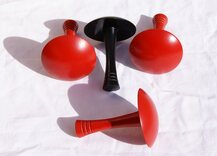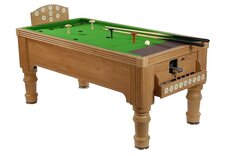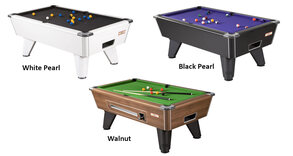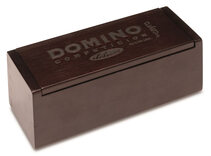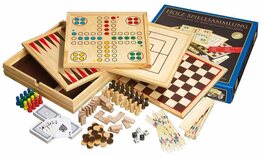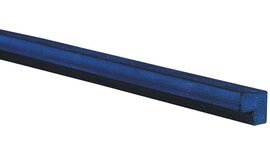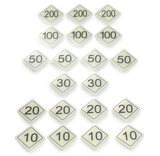The Rules of Bar Billiards
Bar Billiards, also known as Russian Billiards is widely played across the South of England and in the Channel Islands. Being a traditional pub game without any national governing body, variations of equipment and rules abound. Where there is doubt, locally played rules should always apply. Note: 1 foot = 30.48 cm
See also: Bar Billiards Tables and Spares.
Equipment
A Bar Billiards table is similar to a small Billiards table and comes with seven white balls and one red ball. The typical English game is most traditionally played on either a Sams or a Jelkes table which is 33.5 inches wide x 56-56.5 inches from spot to far corner. Sometimes, you see a thinner version of the Sams table that would not conform to most leagues - 30 x 60 inches. The tables more commonly used in the Channel Islands are made by Burroughs and Watts are believed to be 34 x 69 inches. Instead of pockets, holes are sunk into the table; 5 in a row across the far end of the table and four set in a diamond pattern in the rear half of the table. The nearest hole to the front, worth 200 points, has a black skittle in front of it which must not be toppled. Next up are two holes near the sides of the table that are each worth 50 points. Then there is a hole worth 100 points in the middle of the table. The holes across the end of the table score 30, 20, 10, 20 and 30 respectively (on some tables, the configuration is 10, 20, 30, 20, 10). Finally, there is a spot in front of the 200 hole for the red ball and a baulk line across the width of the table near the front with a small D extending forwards from it. The skittle arrangements can vary but the black skittle always lies in front of the 200 hole and forfeits the entire score if toppled. Skittles are either thin pins with a bar through the top to prevent them falling into a hole or mushroom shaped. Here are all known arrangements:
- 1 black, 2 white or red. The white/red skittles forfeit only the current break score if toppled. The white/red skittles are usually positioned either side of the 100 hole.
- 1 black, 2 white, 1 red. The white skittles are sometimes positioned either side of the 100 hole but more commonly, in this difficult variant, positioned in front of the 50 holes. They foreit the current break score if toppled. The red skittle is positioned in front of the 100 hole and like the black skittle, forfeits the entire score if toppled.
- 1 black, 3 reds in front of 100 and 50 holes. This option usually features the mushroom shaped skittles. The red skittles forfeit just the current break score if toppled.
The Start
A flip of a coin decides who starts. The game starts with the red ball on it's spot. The player to start takes a white ball from the trough at the front of the table and places it in the D for the first strike. The game is normally played by 2 people but can also be played by 3 or 4 players.
Basic Play
Each turn consists of a number of strikes and comes to an end when a player makes a non-scoring strike or a foul stroke. A strike is taken by the player taking a white or red ball from a trough at the front of the table, putting it within the D at the front of the table and then hitting it with the cue. Normally, players will pick the red ball if it's available because this gives double points. The aim is to strike another ball on the table in such a way that at least one ball ends up rolling into a hole. If this is achieved, the player continues his break with the next ball. Any white ball that falls into a hole scores the number of points indicated by that hole. If the red ball falls into a hole, it scores double the points indicated by that hole. A foul is committed by:
- knocking over a skittle
- causing a ball to return back behind the baulk line
- failing to hit any other ball with the cue ball
- causing a ball to leave the table.
Less oft-used Rules
- If there are no balls available from the trough with which to take a strike, the ball nearest to the baulk line is retrieved instead.
- If a skittle is knocked over and a ball prevents it being replaced, the ball should be returned to baulk.
- If a ball comes to rest in the D, it should be returned to baulk.
- If a skittle is moved but not knocked over, the skittle should be returned to it's spot before the next strike.
- Where a strike causes both a white and a black skittle to be knocked down, if the black skittle was toppled first, the black skittle penalty is taken (entire score is reset to zero); if the white skittle was toppled first, the white skittle penalty is taken (that turn scores nothing).
Finishing
Normally, the games are coin-operated and each coin gives a game of a certain length of time between 15.5 and 19 minutes. After that time, the baffle-bar drops inside the table which prevents potted balls from returning to the trough at the front of the table. Once that happens, play continues as described above but the number of balls in play gradually decreases. Sometimes, the last 2 or 3 balls are all potted in one strike in which case the game ends at that point but, more usually, the time comes when there is only one ball left.
The Final Ball
If it happens that only one ball remains, a special rule comes into force. Before it is struck, the two white skittles are placed into the 50 holes and the top holes are guarded to prevent the ball being lost into any of those holes. Then, the game can only be ended by a player hitting the ball from the D in such a way that it bounces off the side cushion and falls into the the 100 hole or 200 hole. Needless to say, the risk of knocking over the black skittle while attempting to achieve this feat is significant. Players take turns to do this until either the ball is successfully potted in the 100 hole or 200 hole or else the game is forfeited because the ball falls into a different hole or the black skittle is knocked over.
If the final ball strikes one of the white skittles, this is a foul and if the ball should then enter the 100 or 200 holes, the game is forfeited.
Of course, in the case where the difference in points is greater than 200, there isn't much point in continuing because the leading player can avoid going anywhere near the skittles and be guaranteed the win. Technically, the game isn't finished until the last ball is sunk but it is normal in this case for the losing player to offer his hand and concede the game.
Variations
Alternative rules and table variations abound. The time of the game can be set from anywhere between 5 minutes and 20 minutes, the number of balls and skittles can vary. Values of holes can differ as can precisely where the skittles are located. Some rules state that the red ball is always placed back onto it's spot each time it is potted. Others have a spot for the first white ball too. Some rules say that the last ball can only be potted in the 200 hole.
These rules are provided by Masters Traditional Games, an Internet shop selling quality traditional games, pub games and unusual games. For general information or for copying and copyright, see our Rules Information page.
Our rules are comprehensive instructions for friendly play. If in doubt, always abide by locally-played or house rules.
Copyright James Masters, 2025. All rights reserved.




